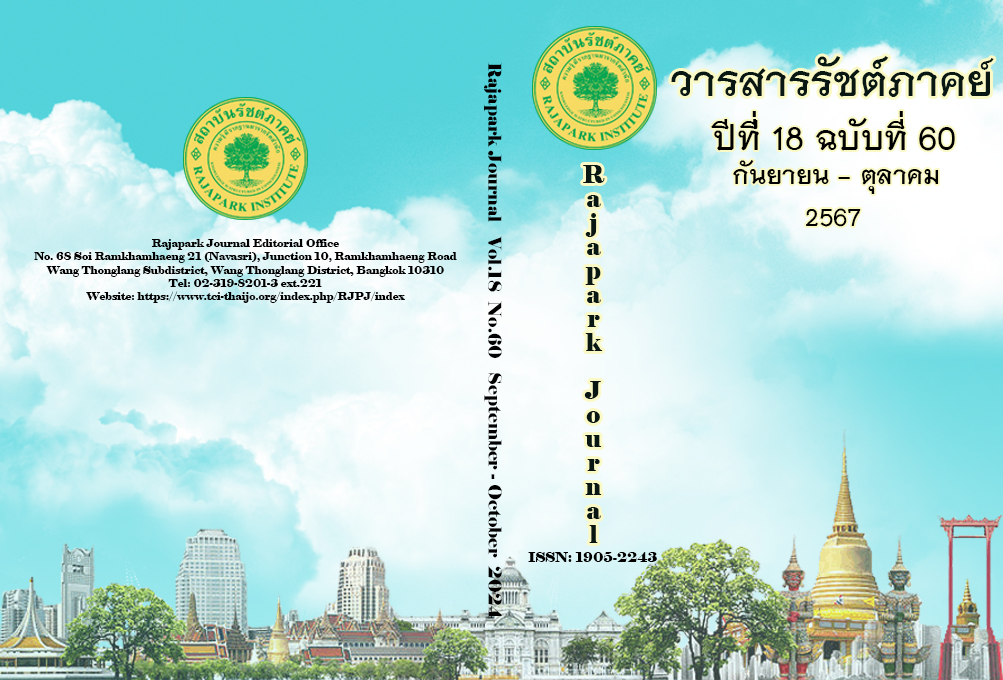Legal Measures for Control of Noise Pollution from Mass Rapid Transit
Main Article Content
Abstract
This research aimed to 1) study the importance of issues, situations, and the impact of noise pollution from the Mass Rapid Transit system in Thailand; 2) study the basic environmental principles and guidelines from the World Health Organization, government policies, and laws related to prevention and addressing noise pollution from the Mass Rapid Transit systems in England, the United States, and South Korea; 3) study the laws and policies related to preventing and addressing noise pollution from the Mass Rapid Transit system in Thailand; and 4) prepare recommendations, guidelines, and legal measures to prevent and address noise pollution issues from the Mass Rapid Transit within the context of Thai society. This research project is qualitatively based on documentary analysis with data collection, textbooks, related articles, and electronic information from domestic and international sources. The research findings indicate that Thailand’s laws currently lack specific provisions for controlling noise pollution from Mass Rapid Transit and the existing provisions that could potentially be applied to such cases are inadequate. The researcher therefore proposes policy recommendations to expedite the completion of the 15-year Master Plan for Noise and Vibration Pollution Management (2023 – 2037) by the Pollution Control Department. Enhance policies to increase the number of specialized personnel in controlling noise pollution from mass rapid transit and allocate additional funding for controlling noise pollution from mass rapid transit. Legal Recommendations: In the short term, propose the enactment of secondary legislation to establish noise standards and methodologies for measuring noise levels from mass rapid transit. Advocate for designating "Mass Rapid Transit" as a pollution source requiring regulation under Section 68 of the Enhancement and Conservation of National Environmental Quality Act, B.E. 2535. In the long term, propose the drafting of ‘the Noise Pollution Control Act B.E. ...,’ a new legislation specifically addressing all aspects of noise pollution control and defining a category specifically for regulating noise pollution from mass rapid transit.
Article Details

This work is licensed under a Creative Commons Attribution-NonCommercial-NoDerivatives 4.0 International License.
Views and opinions appearing in the Journal it is the responsibility of the author of the article, and does not constitute the view and responsibility of the editorial team.
References
Berglund, B., Lindvall, T., Schwela, D.H. & WHO. Occupational and Environmental Health Team. (1999). Guidelines for community noise. https://apps.who.int/iris/handle/10665/66217
Choeychid, W. (2016). Conditions for applying precautionary principle under the agreement on the application of sanitary and phytosanitary measures[Master’s Thesis, Thammasat University].
https://ethesisarchive.library.tu.ac.th/thesis/2016/TU_2016_5601032617_6886_5322.pdf
Chuin, S. (2013). Introduction to noise pollution. Chulalongkorn University.
Department of Environment Food and Rural Affair. (2023, July 13) Noise Policy Statement for England (NPSE). https://assets.publishing.service.gov.uk/government/uploads/system/uploads /attachment_data/file/69533/pb13750-noise-policy.pdf
ENLAWTHAI Foundation. (2020, May 25). Right to live in healthy environment (That disappear from the draft of constitution). https://enlawfoundation.org/newweb/?p=2894
EUR-Lex. (2023, May 17). Future noise policy European commission green paper.
https://eur-lex.europa.eu/legal-content/EN/TXT/PDF/?uri=CELEX:51996DC0540&from=PT
European Commission. (2022, November 15). Air quality and noise legislation: Module 3: Environmental Noise Directive (END) Directive 2002/49/ EC: historical overview, aims and main features-introduction. https://ec.europa.eu/environment/legal/law/5/e_learning/module_3_1.htm
European Commission. (2022, November 15). Air quality and noise legislation: Module 3: Environmental Noise Directive (END) Directive 2002/49/ EC: historical overview, aims and main features-adoption of directive 2002/49/ EC. https://ec.europa.eu/environment/legal/law/5/e_learning/module_3_2.htm
European Commission. (2022, November 15). Air quality and noise legislation: Module 3: Environmental Noise Directive (END) links between directive 2002/49 and other noise-related EU legislation-rail traffic. https://ec.europa.eu/environment/legal/law/5/e_learning /module_3_12.htm
Federal Transit Administration U.S. Department of Transportation. (2023, May 29). Transit noise and vibration impact assessment manual. federal transit administration U.S. department of transportation. https://www.transit.dot.gov/sites/fta.dot.gov/files/docs/research-innovation/118131/transit-noise-and-vibration-impact-assessment-manual-fta-report-no-0123_0.pdf
Government Policy and OFR Procedures. (2023, May 29). Code of federal Regulations Title 24 Subtitle A Part 51. https://www.ecfr.gov/current/title-24/subtitle-A/part-51
Government Policy and OFR Procedures. (2023, May 29). Code of federal Regulations Title 40. https://www.ecfr.gov/current/title-40
Malilee, P. (2020, May 1). Bangkok metropolitan region mass rapid transit map complete edition. Home.co.th. https://www.home.co.th/hometips/detail/89169
Mass Rapid Transit Authority of Thailand. (2024, August 15) Background. Mass Rapid Transit Authority of Thailand. https://www.mrta.co.th/th/history/457
Iberdrola. (2023, May 29) Noise pollution: How to reduce the impact of an invisible threat?. https://www.iberdrola.com/sustainability/what-is-noise-pollution-causes-effects-solutions
Environmental Academic Subcommittee on Noise, Office of the National Environment Board. (1981). Noise pollutions. Sarnmualchon.
Murphy, E., & King, E.A. (2014). Environmental noise pollution: Noise mapping, public health, and policy. Elsevier.
Office of the National Economic and Social Development Council. (2023, July 11). About SDGs. https://www.sdgmove.com/intro-to-sdgs/
PPTV Online. (2021, September 19). The residents complain about noise from mass rapid transit. https://www.pptvhd36.com/news
Pollution Control Department. (2017). The situation and the control of air and noise pollution problems in Thailand, 2017. http://www.oic.go.th/FILEWEB/CABINFOCENTER3/DRAWER056/GENERAL/DATA0001/00001436.PDF
Repository & Open Science Access Portal. (2023, May 29). Guidelines for design of rapid transit facilities. National Transportation Library, United States Department of Transportation. https://rosap.ntl.bts.gov/view/dot/15094
Sinthinpong, U. (2018). Environmental law (5th ed.). Winyuchon.
United Kingdom Legislation. (2006). The environmental noise (England) regulations 2006. https://www.legislation.gov.uk/uksi/2006/2238/contents/made
WHO, Regional Office for Europe. (2009). Night noise guidelines for Europe. https://iris.who.int/handle/10665/326486
WHO, Regional Office for Europe. (2019, January 30). Environmental noise guidelines for the European Region. https://www.who.int/europe/publications/i/item/9789289053563
Wongbandit, A. (2019). Environmental law (4th ed.). Winyuchon.
Yang, X., Jia, X., Dong, W., Wu, S., Miller, M.R., Hu, D., et al. (2018). Cardiovascular benefits of reducing personal exposure to traffic-related noise and particulate air pollution: A randomized crossover study in the Beijing subway system. Indoor Air, 28, 777-786.


